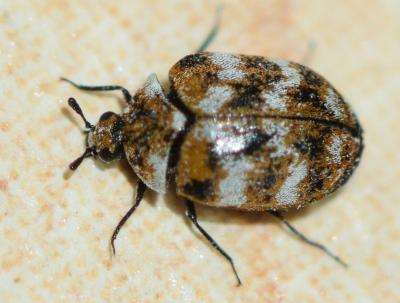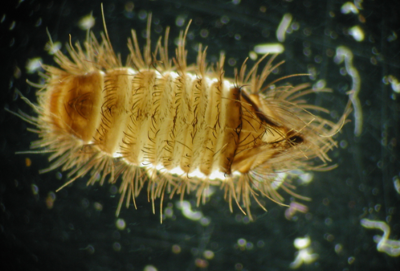Carpet Beetles
Carpet beetles, though small in size, can cause significant damage to our homes and belongings. These tiny intruders belong to the family Dermestidae and are known for their penchant for consuming natural fibers, such as carpets, clothing, and upholstery.
 Carpet beetles come in various species, with the most common being the varied carpet beetle, black carpet beetle, and furniture carpet beetle. Measuring only 1/16 to 1/8 inch in length, these insects often go unnoticed until their presence is revealed by the damage they cause. Adult carpet beetles are typically small, oval-shaped insects with patterns of scales on their bodies, while larvae are characterized by their bristly appearance.
Carpet beetles come in various species, with the most common being the varied carpet beetle, black carpet beetle, and furniture carpet beetle. Measuring only 1/16 to 1/8 inch in length, these insects often go unnoticed until their presence is revealed by the damage they cause. Adult carpet beetles are typically small, oval-shaped insects with patterns of scales on their bodies, while larvae are characterized by their bristly appearance.
The lifecycle of a carpet beetle consists of four stages: egg, larva, pupa, and adult. Adult carpet beetles lay their eggs in areas where larvae can find an ample supply of food, such as carpets, woolens, furs, and animal nests. Once hatched, larvae are voracious eaters, consuming organic materials and molting several times before pupating. The pupa eventually transforms into an adult beetle, completing the life cycle.
 Carpet beetle larvae are responsible for the most significant damage, as they feed on a variety of organic materials, including natural fibers, hair, pet fur, and even stored food products. The damage they cause can be extensive and costly, especially when infestations go unnoticed for an extended period. Common signs of carpet beetle damage include irregular holes in fabrics, shed skins, and fecal pellets that resemble coarse, sand-like material.
Carpet beetle larvae are responsible for the most significant damage, as they feed on a variety of organic materials, including natural fibers, hair, pet fur, and even stored food products. The damage they cause can be extensive and costly, especially when infestations go unnoticed for an extended period. Common signs of carpet beetle damage include irregular holes in fabrics, shed skins, and fecal pellets that resemble coarse, sand-like material.
To protect your home from carpet beetle infestations, consider the following preventive measures:
- Regular Cleaning: Vacuuming carpets, upholstery, and other potential breeding grounds for carpet beetles can help eliminate eggs and larvae.
- Seal Entry Points: Ensure that windows and doors are properly sealed to prevent adult beetles from entering your home.
- Storage Practices: Store clothing, linens, and other susceptible items in airtight containers to reduce the risk of infestation.
- Regular Inspections: Conduct routine inspections of susceptible areas, especially if you have natural fiber items in your home.
- Professional Pest Control: If an infestation is already underway, seeking the assistance of a pest control professional can help address the issue effectively.
